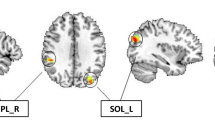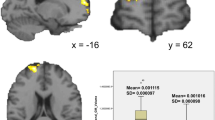Abstract
Case–control studies comparing ADHD with typically developing individuals suggest that anatomical asymmetry of the caudate nucleus is a marker of attention deficit hyperactivity disorder (ADHD). However, there is no consensus on whether the asymmetry favors the right or left caudate nucleus in ADHD, or whether the asymmetry is increased or decreased in ADHD. The current study aimed to clarify this relationship by applying a dimensional approach to assessing ADHD symptoms that, instead of relying on clinical classification, utilizes the natural behavioral continuum of traits related to ADHD. Structural T1-weighted MRI was collected from 71 adults between 18 and 35 years and analyzed for caudate asymmetry. ADHD-like attentional symptoms were assessed with an objective measure of attentional problems, the ADHD score from the Test of Variables of Attention (TOVA). Impulsivity, a core feature in ADHD, was measured using the Barratt Impulsiveness Scale, a self-report measure that assesses attentional, non-planning, and motor features of impulsivity. We found that larger right relative to left caudate volumes correlated with both higher attentional impulsiveness and worse ADHD scores on the TOVA. Higher attentional impulsiveness also correlated with worse ADHD scores, establishing coherence between the objective measure and the self-report measure of attentional problems. These results suggest that a differential passage of information through frontal–striatal networks may produce instability leading to attentional problems. The findings also demonstrate the utility of a dimensional approach to understanding structural correlates of ADHD symptoms.





Similar content being viewed by others
References
Alexander GE, Crutcher MD, DeLong MR (1990) Basal ganglia-thalamocortical circuits: parallel substrates for motor, oculomotor, “prefrontal” and “limbic” functions. Prog Brain Res 85:119–146
Bjorklund A, Dunnett SB (2007) Dopamine neuron systems in the brain: an update. Trends Neurosci 30:194–202
Brown RT, Freeman WS, Perrin JM, Stein MT, Amler RW, Feldman HM, Pierce K, Wolraich ML (2001) Prevalence and assessment of attention-deficit/hyperactivity disorder in primary care settings. Pediatrics 107:E43
Carter CS, Krener P, Chaderjian M, Northcutt C, Wolfe V (1995) Asymmetrical visual-spatial attentional performance in ADHD: evidence for a right hemispheric deficit. Biol Psychiatry 37:789–797
Castellanos FX, Giedd JN, Marsh WL, Hamburger SD, Vaituzis AC, Dickstein DP, Sarfatti SE, Vauss YC, Snell JW, Lange N, Kaysen D, Krain AL, Ritchie GF, Rajapakse JC, Rapoport JL (1996) Quantitative brain magnetic resonance imaging in attention-deficit hyperactivity disorder. Arch Gen Psychiatry 53:607–616
Castellanos FX, Lee PP, Sharp W, Jeffries NO, Greenstein DK, Clasen LS, Blumenthal JD, James RS, Ebens CL, Walter JM, Zijdenbos A, Evans AC, Giedd JN, Rapoport JL (2002) Developmental trajectories of brain volume abnormalities in children and adolescents with attention-deficit/hyperactivity disorder. JAMA 288:1740–1748
Cools R, Robbins TW (2004) Chemistry of the adaptive mind. Philos Transact A Math Phys Eng Sci 362:2871–2888
Cools R, Barker RA, Sahakian BJ, Robbins TW (2001a) Enhanced or impaired cognitive function in Parkinson’s disease as a function of dopaminergic medication and task demands. Cereb Cortex 11:1136–1143
Cools R, Barker RA, Sahakian BJ, Robbins TW (2001b) Mechanisms of cognitive set flexibility in Parkinson’s disease. Brain 124:2503–2512
Cortese S, Castellanos FX (2012) Neuroimaging of attention-deficit/hyperactivity disorder: current neuroscience-informed perspectives for clinicians. Curr Psychiatry Rep 14:568–578
Crofts HS, Dalley JW, Collins P, Van Denderen JC, Everitt BJ, Robbins TW, Roberts AC (2001) Differential effects of 6-OHDA lesions of the frontal cortex and caudate nucleus on the ability to acquire an attentional set. Cereb Cortex 11:1015–1026
Cubillo A, Halari R, Smith A, Taylor E, Rubia K (2012) A review of fronto-striatal and fronto-cortical brain abnormalities in children and adults with Attention Deficit Hyperactivity Disorder (ADHD) and new evidence for dysfunction in adults with ADHD during motivation and attention. Cortex 48:194–215
Cuffe SP, Moore CG, McKeown RE (2005) Prevalence and correlates of ADHD symptoms in the national health interview survey. J Atten Disord 9:392–401
Dang LC, Donde A, Madison C, O’Neil JP, Jagust WJ (2012) Striatal dopamine influences the default mode network to affect shifting between object features. J Cogn Neurosci 24:1960–1970
Ducharme S, Hudziak JJ, Botteron KN, Albaugh MD, Nguyen TV, Karama S, Evans AC (2012) Decreased regional cortical thickness and thinning rate are associated with inattention symptoms in healthy children. J Am Acad Child Adolesc Psychiatry 51(18–27):e12
Filipek PA, Semrud-Clikeman M, Steingard RJ, Renshaw PF, Kennedy DN, Biederman J (1997) Volumetric MRI analysis comparing subjects having attention-deficit hyperactivity disorder with normal controls. Neurology 48:589–601
First MB, Spitzer RL, Gibbon M, Williams JBW (1997) Structured clinical interview for DSM-IV axis I disorders (SCID-I). American Psychiatric Publishing Inc, Washington
Froehlich TE, Lanphear BP, Epstein JN, Barbaresi WJ, Katusic SK, Kahn RS (2007) Prevalence, recognition, and treatment of attention-deficit/hyperactivity disorder in a national sample of US children. Arch Pediatr Adolesc Med 161:857–864
Gumenyuk V, Korzyukov O, Escera C, Hamalainen M, Huotilainen M, Hayrinen T, Oksanen H, Naatanen R, von Wendt L, Alho K (2005) Electrophysiological evidence of enhanced distractibility in ADHD children. Neurosci Lett 374:212–217
Heilman KM, Voeller KK, Nadeau SE (1991) A possible pathophysiologic substrate of attention deficit hyperactivity disorder. J Child Neurol 6(Suppl):S76–S81
Hynd GW, Hern KL, Novey ES, Eliopulos D, Marshall R, Gonzalez JJ, Voeller KK (1993) Attention deficit-hyperactivity disorder and asymmetry of the caudate nucleus. J Child Neurol 8:339–347
Insel T, Cuthbert B, Garvey M, Heinssen R, Pine DS, Quinn K, Sanislow C, Wang P (2010) Research domain criteria (RDoC): toward a new classification framework for research on mental disorders. Am J Psychiatry 167:748–751
Leark RA, Greenberg LK, Kindschi CL, Dupuy TR, Hughes SJ (2008) Test of Variables of Attention: Professional Manual. The TOVA Company, Los Alamitos
Leh SE, Ptito A, Chakravarty MM, Strafella AP (2007) Fronto-striatal connections in the human brain: a probabilistic diffusion tractography study. Neurosci Lett 419:113–118
Marklund P, Larsson A, Elgh E, Linder J, Riklund KA, Forsgren L, Nyberg L (2009) Temporal dynamics of basal ganglia under-recruitment in Parkinson’s disease: transient caudate abnormalities during updating of working memory. Brain 132:336–346
McAlonan GM, Cheung V, Chua SE, Oosterlaan J, Hung SF, Tang CP, Lee CC, Kwong SL, Ho TP, Cheung C, Suckling J, Leung PW (2009) Age-related grey matter volume correlates of response inhibition and shifting in attention-deficit hyperactivity disorder. Br J Psychiatry 194:123–129
Monchi O, Ko JH, Strafella AP (2006) Striatal dopamine release during performance of executive functions: a [(11)C] raclopride PET study. Neuroimage 33:907–912
Nakao T, Radua J, Rubia K, Mataix-Cols D (2011) Gray matter volume abnormalities in ADHD: voxel-based meta-analysis exploring the effects of age and stimulant medication. Am J Psychiatry 168:1154–1163
Newcorn JH, Halperin JM, Jensen PS, Abikoff HB, Arnold LE, Cantwell DP, Conners CK, Elliott GR, Epstein JN, Greenhill LL, Hechtman L, Hinshaw SP, Hoza B, Kraemer HC, Pelham WE, Severe JB, Swanson JM, Wells KC, Wigal T, Vitiello B (2001) Symptom profiles in children with ADHD: effects of comorbidity and gender. J Am Acad Child Adolesc Psychiatry 40:137–146
Patenaude B, Smith SM, Kennedy DN, Jenkinson M (2011) A Bayesian model of shape and appearance for subcortical brain segmentation. Neuroimage 56:907–922
Patton JH, Stanford MS, Barratt ES (1995) Factor structure of the Barratt impulsiveness scale. J Clin Psychol 51:768–774
Pliszka SR, Liotti M, Woldorff MG (2000) Inhibitory control in children with attention-deficit/hyperactivity disorder: event-related potentials identify the processing component and timing of an impaired right-frontal response-inhibition mechanism. Biol Psychiatry 48:238–246
Pliszka SR, Lancaster J, Liotti M, Semrud-Clikeman M (2006) Volumetric MRI differences in treatment-naive vs chronically treated children with ADHD. Neurology 67:1023–1027
Pueyo R, Maneru C, Vendrell P, Mataro M, Estevez-Gonzalez A, Garcia-Sanchez C, Junque C (2000) Attention deficit hyperactivity disorder. Cerebral asymmetry observed on magnetic resonance. Rev Neurol 30:920–925
Qiu A, Crocetti D, Adler M, Mahone EM, Denckla MB, Miller MI, Mostofsky SH (2009) Basal ganglia volume and shape in children with attention deficit hyperactivity disorder. Am J Psychiatry 166:74–82
Schneider M, Retz W, Coogan A, Thome J, Rosler M (2006) Anatomical and functional brain imaging in adult attention-deficit/hyperactivity disorder (ADHD)—a neurological view. Eur Arch Psychiatry Clin Neurosci 256(Suppl 1):i32–i41
Schrimsher GW, Billingsley RL, Jackson EF, Moore BD 3rd (2002) Caudate nucleus volume asymmetry predicts attention-deficit hyperactivity disorder (ADHD) symptomatology in children. J Child Neurol 17:877–884
Semrud-Clikeman M, Steingard RJ, Filipek P, Biederman J, Bekken K, Renshaw PF (2000) Using MRI to examine brain-behavior relationships in males with attention deficit disorder with hyperactivity. J Am Acad Child Adolesc Psychiatry 39:477–484
Shaw P, Rabin C (2009) New insights into attention-deficit/hyperactivity disorder using structural neuroimaging. Curr Psychiatry Rep 11:393–398
Shaw P, Gilliam M, Liverpool M, Weddle C, Malek M, Sharp W, Greenstein D, Evans A, Rapoport J, Giedd J (2011) Cortical development in typically developing children with symptoms of hyperactivity and impulsivity: support for a dimensional view of attention deficit hyperactivity disorder. Am J Psychiatry 168:143–151
Shulman GL, Pope DL, Astafiev SV, McAvoy MP, Snyder AZ, Corbetta M (2010) Right hemisphere dominance during spatial selective attention and target detection occurs outside the dorsal frontoparietal network. J Neurosci 30:3640–3651
Simon SR, Meunier M, Piettre L, Berardi AM, Segebarth CM, Boussaoud D (2002) Spatial attention and memory versus motor preparation: premotor cortex involvement as revealed by fMRI. J Neurophysiol 88:2047–2057
Stefanatos GA, Wasserstein J (2001) Attention deficit/hyperactivity disorder as a right hemisphere syndrome. Selective literature review and detailed neuropsychological case studies. Ann N Y Acad Sci 931:172–195
Steinberg L, Albert D, Cauffman E, Banich M, Graham S, Woolard J (2008) Age differences in sensation seeking and impulsivity as indexed by behavior and self-report: evidence for a dual systems model. Dev Psychol 44:1764–1778
Sylvester CY, Wager TD, Lacey SC, Hernandez L, Nichols TE, Smith EE, Jonides J (2003) Switching attention and resolving interference: fMRI measures of executive functions. Neuropsychologia 41:357–370
Team RDC (2011) R: a language and environment for statistical computing. R Foundation for Statistical Computing, Vienna
Tomer R, Goldstein RZ, Wang GJ, Wong C, Volkow ND (2008) Incentive motivation is associated with striatal dopamine asymmetry. Biol Psychol 77:98–101
Uhlikova P, Paclt I, Vaneckova M, Morcinek T, Seidel Z, Krasensky J, Danes J (2007) Asymmetry of basal ganglia in children with attention deficit hyperactivity disorder. Neuro Endocrinol Lett 28:604–609
Woodward ND, Zald DH, Ding Z, Riccardi P, Ansari MS, Baldwin RM, Cowan RL, Li R, Kessler RM (2009) Cerebral morphology and dopamine D2/D3 receptor distribution in humans: a combined [18F]fallypride and voxel-based morphometry study. Neuroimage 46:31–38
Wu YH, Gau SS, Lo YC, Tseng WY (2012) White matter tract integrity of frontostriatal circuit in attention deficit hyperactivity disorder: Association with attention performance and symptoms. Hum Brain Mapp. doi:10.1002/hbm.22169
Zhang K, Sejnowski TJ (2000) A universal scaling law between gray matter and white matter of cerebral cortex. Proc Natl Acad Sci USA 97:5621–5626
Acknowledgments
This research was supported by two grants from the National Institute of Drug Abuse to David Zald: R21DA033611 and 5R01DA019670. Gregory Samanez-Larkin was supported by National Institute on Aging Pathway to Independence Award K99AG042596.
Conflict of interest
The authors declare that they have no conflict of interest.
Author information
Authors and Affiliations
Corresponding author
Rights and permissions
About this article
Cite this article
Dang, L.C., Samanez-Larkin, G.R., Young, J.S. et al. Caudate asymmetry is related to attentional impulsivity and an objective measure of ADHD-like attentional problems in healthy adults. Brain Struct Funct 221, 277–286 (2016). https://doi.org/10.1007/s00429-014-0906-6
Received:
Accepted:
Published:
Issue Date:
DOI: https://doi.org/10.1007/s00429-014-0906-6




